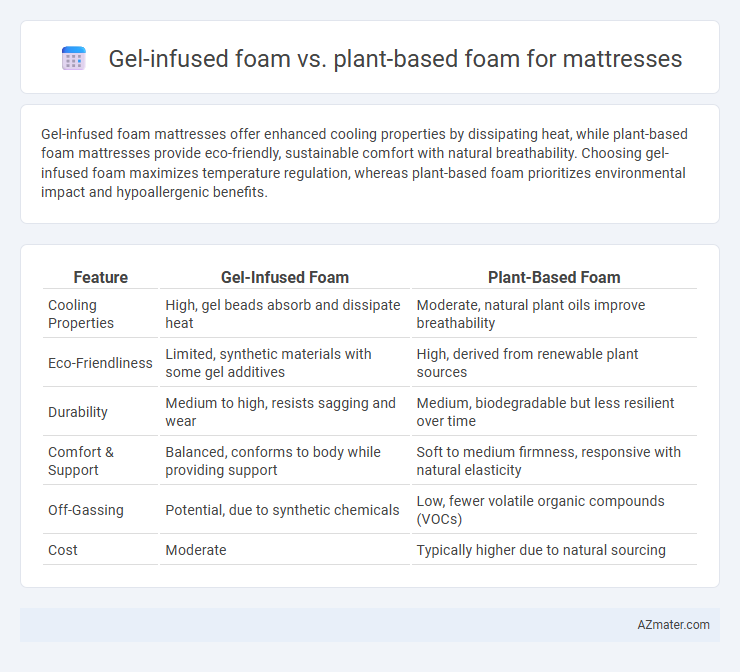Gel-infused foam mattresses offer enhanced cooling properties by dissipating heat, while plant-based foam mattresses provide eco-friendly, sustainable comfort with natural breathability. Choosing gel-infused foam maximizes temperature regulation, whereas plant-based foam prioritizes environmental impact and hypoallergenic benefits.
Table of Comparison
| Feature | Gel-Infused Foam | Plant-Based Foam |
|---|---|---|
| Cooling Properties | High, gel beads absorb and dissipate heat | Moderate, natural plant oils improve breathability |
| Eco-Friendliness | Limited, synthetic materials with some gel additives | High, derived from renewable plant sources |
| Durability | Medium to high, resists sagging and wear | Medium, biodegradable but less resilient over time |
| Comfort & Support | Balanced, conforms to body while providing support | Soft to medium firmness, responsive with natural elasticity |
| Off-Gassing | Potential, due to synthetic chemicals | Low, fewer volatile organic compounds (VOCs) |
| Cost | Moderate | Typically higher due to natural sourcing |
Introduction: Understanding Gel-Infused and Plant-Based Foams
Gel-infused foam incorporates cooling gel beads that enhance airflow and dissipate heat, providing a cooler sleep surface ideal for hot sleepers. Plant-based foam, derived from renewable resources like soy or castor oil, offers eco-friendly benefits while maintaining pressure relief and support. Both foams vary in density and responsiveness, catering to different comfort preferences and sustainability priorities.
Material Composition: Breaking Down the Differences
Gel-infused foam mattresses feature polyurethane foam infused with cooling gel beads designed to dissipate heat and enhance temperature regulation for improved sleep comfort. Plant-based foam mattresses use a significant percentage of natural oils, such as soy or castor oil, which replace a portion of petroleum-based polyols, resulting in a more eco-friendly and sustainable material composition. The key difference lies in gel-infused foam's focus on thermal management through gel integration, while plant-based foam emphasizes renewable resources and reduced environmental impact.
Cooling Performance: Gel-Infused vs. Plant-Based Foam
Gel-infused foam offers superior cooling performance by incorporating gel beads that absorb and dissipate heat more effectively, reducing mattress surface temperature. Plant-based foam, derived from natural oils like soy, provides moderate breathability but generally retains more heat compared to gel-infused alternatives. Choosing gel-infused foam caters better to hot sleepers seeking enhanced airflow and temperature regulation for a cooler night's rest.
Comfort and Support: Which Foam Delivers Better?
Gel-infused foam offers superior temperature regulation and pressure relief, providing enhanced comfort for hot sleepers by dissipating heat more effectively than traditional foams. Plant-based foam increases breathability and reduces chemical odors, delivering firmer support with a more eco-friendly profile that appeals to environmentally conscious users. Choosing between gel-infused and plant-based foam depends on prioritizing cooling comfort versus sustainable, resilient support in mattress construction.
Durability and Lifespan Comparison
Gel-infused foam mattresses typically offer enhanced durability due to their ability to maintain shape and resist sagging over time, often lasting between 7 to 10 years. Plant-based foam, made from renewable materials like soy or castor oil, tends to have a slightly shorter lifespan, averaging around 5 to 8 years, because of its softer, more biodegradable composition. Consumers seeking long-term investment in mattress longevity often prefer gel-infused foam for its superior resilience and consistent support.
Environmental Impact: Sustainability and Eco-Friendliness
Gel-infused foam mattresses often contain synthetic materials derived from petrochemicals, which contribute to environmental pollution and longer decomposition times in landfills. Plant-based foam utilizes renewable resources like soy or castor oil, significantly reducing carbon footprint and reliance on fossil fuels. The biodegradable nature and lower emissions during production make plant-based foam a more sustainable and eco-friendly choice for mattress consumers.
Health and Safety: Off-Gassing and Allergen Concerns
Gel-infused foam mattresses typically emit fewer volatile organic compounds (VOCs) during off-gassing compared to traditional foams but can still release chemicals that may irritate sensitive individuals. Plant-based foam mattresses are often praised for lower VOC emissions due to their natural ingredients, reducing off-gassing concerns and promoting better indoor air quality. Both materials can pose allergen risks depending on manufacturing processes, but plant-based foams generally offer a hypoallergenic advantage with fewer synthetic additives.
Price Differences and Value for Money
Gel-infused foam mattresses typically cost more than plant-based foam options due to advanced cooling technology and enhanced pressure relief features. Plant-based foam mattresses offer a more affordable price point while providing eco-friendly benefits and sufficient comfort for many sleepers. Assessing value for money involves balancing the higher upfront cost of gel-infused foam against its long-term cooling performance versus the budget-friendly, sustainable qualities of plant-based foam.
Consumer Preferences: Popularity and Market Trends
Gel-infused foam mattresses have gained popularity for their superior temperature regulation and pressure relief, appealing to consumers seeking a cooler sleep experience. Plant-based foam mattresses attract eco-conscious buyers due to their sustainable materials and reduced chemical use, reflecting a growing trend toward environmentally friendly products. Market data shows increasing demand for both types, with gel-infused foams favored for performance and plant-based foams for sustainability, driving innovation in mattress manufacturing.
Final Verdict: Choosing the Right Foam for Your Mattress
Gel-infused foam regulates temperature effectively by dispersing heat, making it ideal for hot sleepers who need consistent cooling. Plant-based foam offers eco-friendly benefits and enhances breathability while providing a responsive, supportive feel preferred by eco-conscious consumers. Your choice depends on prioritizing thermal regulation or sustainable materials for mattress comfort and performance.

Infographic: Gel-infused foam vs Plant-based foam for Mattress
 azmater.com
azmater.com